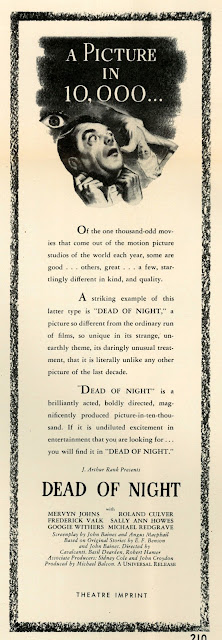When Critics Liked A Universal Horror Release
A British Way To Scare: Dead Of Night (1946)
In case you haven't watched, please do, as this is an abiding classic of chiller type where quiet UK countryside becomes stuff of nightmare thanks to five tales of terror wrapped round bucolic setting.
The framing story appears to be merely that until climactic pay-off where all of what went before ties like a noose. Imitators have stole bolts from Dead Of Night cloth, but there's no duplicating atmosphere lost to time that was immediate postwar in
The stories begin brief. A racecar driver crashes and sees portent of doom from his hospital room. This one goes by quick, but packs a punch of Miles Malleson, future light presence at Hammer, as a hearse, then bus, driver issuing cheery invitation to premature death. Then there's Sally Ann Howes telling of a Christmas party where she encountered specter of a years-before murdered child. That one's effective thanks to set design of a house with many a hidden passage; you could easily imagine ghosts making their undetected place here. Third comes the Haunted Mirror, which Everson regarded best of the lot, and here's where intensity ramps up. Audiences maybe needed the light serving that followed of Basil Radford and Naunton Wayne as golfers competing for love as well as on links, with haunting a result of one cheating the other on a bet. It's a weak link in an otherwise taut chain, not unlike the telephone story in Black Sabbath a few decades later, this where some will find usage of DVD's chapter skip feature.
The longest and most ambitious of the lot is a story from which elements just had to have been borrowed for Psycho, so striking are parallels between this tale of a ventriloquist possessed by his dummy and later on Norman Bates by his mother. The device of a ventriloquist performing in edgy opposition to his dummy seems to me an excellent concept for modern-day performing, if such could remain an act and not tip over into reality and consequent madness. There's something inherently frightful about deadly dummies, or devil dolls if you will, these being evergreen to the service of horror, as witness more recent success and sequels in the "Chucky" series. Dead Of Night must have walloped an English public when new. When had they been served home brew potent as this? Horror films had been discouraged for a large part in the
Universal was the natural stateside handler for Dead Of Night, but not necessarily for its horrific content. Fact is, Uni preferred selling DoN as anything but a chiller, opting instead to emphasize "psychological" elements of the package. Suggested press for newspaper use was all over suspense that came of tormented minds, with ghosts and the supernatural played way down. What Universal wanted was another Spellbound, that having rung bells for Selznick-UA. Psychology being a prevailing fad put Dead Of Night into what Universal hoped would be a sophisticated column way above monsters they had but lately separated from. An early trade announcement (2/4/46) tipped Universal's enthusiasm for "dream sequences" they promised would pervade Dead Of Night, "FIVE completely separate dream stories woven into a central pattern," even though, of course, the company would end up dropping two of these before releasing the film in June, 1946.
Lift-off was at





















Comments
Post a Comment